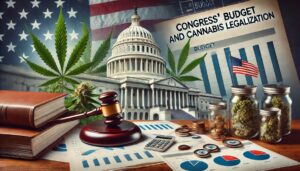In October of 2022, President Joe Biden directed the Attorney General and Health and Human Services (HHS) to evaluate the current Schedule I status of cannabis, called marijuana under the Federal Controlled Substances Act. This directive aimed to reevaluate the classification of cannabis and potentially move it from Schedule I to Schedule III.
 On August 29th, 2023, the HHS applied an 8-factor test under Section 811 of the CSA and sent its findings to the DEA. This comprehensive evaluation process involved assessing various elements of cannabis, including its potential for abuse, scientific evidence of its pharmacological effects, current scientific knowledge, history and pattern of abuse, risk to public health, potential for dependence, and its relation to other controlled substances.
On August 29th, 2023, the HHS applied an 8-factor test under Section 811 of the CSA and sent its findings to the DEA. This comprehensive evaluation process involved assessing various elements of cannabis, including its potential for abuse, scientific evidence of its pharmacological effects, current scientific knowledge, history and pattern of abuse, risk to public health, potential for dependence, and its relation to other controlled substances.
Based on the evaluation, the HHS recommended that cannabis be moved to Schedule III. This recommendation sets in motion a series of events under the Controlled Substances Act. The next steps include the initiation of a new rule or amendment, publication of an advance notice of proposed rulemaking (ANPRM) to seek public input, publication of a notice of proposed rulemaking (NPRM) with specific changes and analysis, a public comment period, review of public comments, publication of a final rule, and the possibility of judicial review.
While the Attorney General has not yet announced a date for publishing an ANPRM on rescheduling cannabis, the Department of Justice has expressed its commitment to reviewing the classification based on the latest scientific evidence. It is important to stay updated on these developments as they unfold.
Once a final rule is published, the effective date of the rescheduling will generally be no less than thirty days after the date of publication in the Federal Register. This means that if the proposed rule is published and allows for a 60-day comment period, the rescheduling of cannabis to Schedule III could potentially happen within a matter of months. Maybe a new federal cannabis license is on the horizon.
However, it’s important to note that even with the rescheduling to Schedule III, cannabis will still be subject to certain regulations and restrictions. International law, specifically the Single Convention on Narcotic Drugs treaty, which the US agreed to in 1961 and incorporated into the CSA in 1970, prevents the complete removal of cannabis from the controlled substance schedules. This means that while there may be changes in the scheduling, cannabis will not be completely legalized due to international legal obligations.
Schedule III Cannabis Defined
In the pharmacologic lexicon, Schedule III substances are classified under the Controlled Substances Act (CSA) as drugs with a moderate to low potential for physical and psychological dependence. Cannabis assigned to this category is recognized for possessing legitimate medical applications, albeit with less restrictive regulatory measures than Schedules I and II drugs. Unlike its Schedule I counterparts, Schedule III cannabis is acknowledged for its therapeutic benefits, and though subject to federal oversight, is granted a conditional acceptance for medical use, providing a nuanced landscape for research and practice.
Classification Criteria
Schedule III classification hinges on a balance between recognized medical use and the potential for dependence.
Cannabis with lower dependence risk can qualify for Schedule III, enhancing therapeutic research opportunities.
A substance must exhibit a moderate to low risk of dependence, both physical and psychological, to be deemed Schedule III.
Substances classified under Schedule III are subject to comprehensive regulatory control, ensuring safety in their legal medical application and distribution.
Comparing Schedules I, II, and III
The classification into Schedules I, II, and III marks distinct legal and regulatory implications for substances.
-
Schedule I substances are deemed to have high potential for abuse, no currently accepted medical use in the U.S., and a lack of accepted safety for use under medical supervision, thus are strictly prohibited.
-
Schedule II substances also have a high potential for abuse but have some accepted medical uses with severe restrictions due to their addictive qualities.
-
Schedule III substances, by contrast, have a lower potential for abuse relative to Schedule I and II substances and are considered to have currently accepted medical use in treatment in the U.S. (IRC Section 280E does not apply).Navigating from Schedule I to Schedule III denotes a transition from a strictly regulated to a more accessible status for medical research and patient care.
The appropriate scheduling of cannabis influences not only its legal accessibility but also research, medical, and commercial opportunities.
Implications for Medical Use
With cannabis categorized under Schedule III, its acknowledged medical utility opens avenues for practitioners to prescribe it within a regulated framework, enhancing its integration into traditional pharmacopeia. Indeed, this reclassification signifies acknowledgment of its therapeutic potential, easing the process for healthcare providers to incorporate cannabis-based treatments into patient care plans.
The reclassification of cannabis illuminates a path toward broader clinical trials and research, enabling a more robust understanding of its efficacy and safety across different medical conditions. Evidently, this shift carries profound implications for the advancement of cannabinoid science and patient access to novel therapies.
Research Opportunities
Schedule III classification of cannabis significantly broadens the scope for scientific study and medical research.
-
Development of new pharmacotherapeutic applications
-
Examination of long-term safety and efficacy
-
Exploration of various dosage forms and delivery systems
-
Investigation into the potential for reducing opioid dependency
-
Analysis of cannabis interactions with other medications
These research opportunities are pivotal for advancing our understanding of cannabis as a therapeutic agent.
With the barriers to research lowered, academia and pharmaceutical companies can engage in more extensive cannabinoid research programs.
Prescribing and Dispensing Limitations
Schedule III designation impacts prescribing practices.
Healthcare providers must adhere to stringent federal and state regulations when prescribing Schedule III cannabis. Stringent record-keeping requirements and verification systems ensure control, reducing the likelihood of diversion or misuse. Equally, state-level variability in prescription protocols can introduce additional layers of complexity for providers.
Limits exist on prescription quantities and refills.
Healthcare practitioners are legally bound to prescribe Schedule III substances – including cannabis – within certain quantity limits and are subject to restrictions on the number of refills without a new prescription.
Practitioners must navigate evolving regulatory landscapes.
As states and federal entities adjust their regulatory frameworks, healthcare providers must stay abreast of changes. For instance, the shift in cannabis scheduling effective 2023 impacts the practicality of the prescribing process, with new protocols emerging that healthcare providers must diligently adopt to maintain compliance
Compliance is under stringent governmental scrutiny.
State and federal agencies closely monitor dispensing of Schedule III substances, utilizing mechanisms such as Prescription Drug Monitoring Programs to track dispensing activities. These measures serve as a deterrent against non-compliance and ensure the integrity of the dispensing process in the healthcare system.
Legal and Regulatory Landscape
Navigating the cannabis licensing process demands an astute awareness of both state and federal regulations, which often exist in a complex and sometimes contradictory relationship. Entities aspiring to operate within the cannabis sector must meticulously dissect these layers of governance, ensuring they align operations with the intricate web of legal stipulations spanning cultivation, distribution, and retail.
Those seeking licensure must prepare for a rigorous vetting process characterized by extensive documentation and compliance protocols. The scrutiny under which applicants are placed serves to uphold the strict standards set forth by regulatory bodies, constructed to govern the production, distribution, and consumption of cannabis with utmost regard for public health and safety.
Federal vs. State Laws
Navigating cannabis legislation requires distinguishing between federal and state frameworks, particularly regarding Schedule III drugs.
While states may enact their own policies, federal law classifies cannabis as a Schedule I substance, indicating high potential for abuse and no accepted medical use.
This discrepancy causes palpable tension, as a business operating legally under state law may still encounter federal legal risks due to the overarching Controlled Substances Act.
For entities seeking cannabis licenses, understanding this legal dichotomy is crucial; non-compliance with federal law can have serious ramifications, despite state-level approval.
Therefore, aligning with state regulations while remaining cognizant of federal constraints is a delicate balance that must be meticulously managed.
Enforcement and Penalties
Non-compliance with cannabis regulations can result in serious consequences.
-
Civil Fines: Entities may be subject to substantial monetary penalties.
-
Criminal Charges: Individuals can face criminal charges, possibly leading to imprisonment.
-
License Revocation: A breach of regulations can result in the loss of operating licenses.
-
Asset Forfeiture: In some cases, non-compliance can lead to seizure of assets.
-
Injunctive Relief: Courts may issue orders to cease operations or rectify violations.Enforcement actions can irreversibly impact a business’s future.
Staying informed and adhering strictly to regulations is absolutely imperative.
Impact on Industry and Research
The classification of cannabis as Schedule III has multifaceted implications for both industry and research. Notably, it alters the regulatory landscape, impacting licensure and product development.
In particular, this reclassification can stimulate research and innovation by easing the constraints around clinical studies and data collection, fostering an environment more conducive to scientific exploration.
However, the “Schedule III” designation still imposes significant limitations, affecting both market potential and research breadth.
Barriers to Commercialization
Navigating complex regulations presents a formidable challenge. Each state’s criteria can vary, causing confusion and delays.
Despite federal reclassification, state policies may not align, generating a patchwork of regulatory environments. Consequently, companies face increased compliance costs and operational complexity.
Moreover, the stigma attached to cannabis lingers, influencing financial institutions’ willingness to engage with businesses. This lack of banking support hampers expansion and commercial viability.
Taxation issues further complicate matters, as entities handling Schedule III substances face stringent financial scrutiny and limitations on tax deductions
Ultimately, effective market entry demands strategic navigation of these multifaceted hurdles.
Boosting Medical Research
The landscape is gradually transforming.
Understanding Schedule III cannabis has opened new avenues for medical research. By loosening the strictures surrounding cannabis, it facilitates increased investigation into potential therapeutic applications. This is crucial since the therapeutic properties of cannabinoids—compounds found in cannabis—are still not fully understood. As such, a Schedule III classification fosters a more liberal atmosphere for scientific inquiry.
Research accelerates with regulatory support.
With the DEA’s oversight somewhat relaxed, Schedule III status permits researchers to obtain cannabis with relative ease for studies. This contrasts starkly with the difficulties associated with Schedule I substances, which are heavily restricted due to their high abuse potential and lack of accepted medical use.
Funding opportunities are on the rise.
Increased access to cannabis for research purposes – as we see with Schedule III status – opens up avenues for federal funding and grants. It is a game-changing shift for the scientific community keen on exploring the medical potential of cannabis.
The door to new treatments stands ajar.
The reclassification to Schedule III paves the way for broader medical research, creating a foundation for new treatment modalities to surface. With the anticipated FDA approval in post-2023 landscape, we expect to witness an uptick in the number of studies targeting specific medical conditions, potentially leading to groundbreaking therapies born from cannabis-based pharmaceuticals.
What is the difference between marijuana and Schedule III Cannabis?
Marijuana and Schedule III cannabis are essentially the same substance, but they are classified differently under the law. The term “marijuana” is commonly used to describe the plant and its psychoactive compounds, primarily THC. On the other hand, Schedule III cannabis refers to the legal classification of cannabis under the Controlled Substances Act (CSA). Cannabis classified as Schedule III has a lower potential for abuse and is recognized for its potential medical benefits. This reclassification would represent a shift towards recognizing the medical value of cannabis while still subjecting it to control and regulation.





